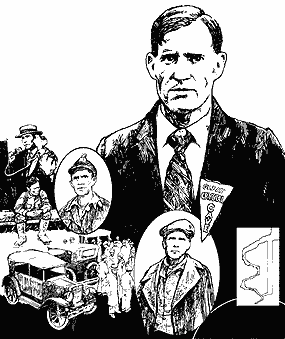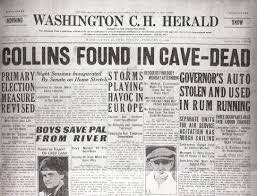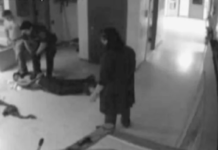“I’m Trapped, and Trapped for Life!”
 Tom Foster The Crystal Cave, owned by the Collins family, lay farthest along the road that ran from Cave City to Flint Ridge. It had been discovered by the youngest son of the family, Floyd Collins, in 1917, and opened as an attraction. But because visitors had to run the entire gauntlet of caves to reach Crystal Cave, few won through to Crystal. The cave made little profit, and Floyd had dreams of riches. He knew of a small cave called Sand Cave, little explored, and situated along the road before many of the other show caves. He determined to explore the Sand Cave, and struck an agreement with the cave’s owner, B. Doyel, to share one half of the profits if the cave proved worthy of show. Floyd entered the cave with a single kerosene lantern, and shortly found that the cave offered challenges. He found himself squeezing through tight passageways – at one point so tight that he had to inch through on his stomach, with one arm stretched out ahead of him, pushing his lantern, and the other arm at his side. Beyond this crawl, the cave began to open up, but his lantern suddenly began to flicker. Floyd knew the peril of losing light in a cave, so he reluctantly began his return journey. But as he returned through the tight crawl, his foot dislodged a 27-pound rock which wedged his ankle, and in his awkward position, he could not remove it. He was trapped in a stone straight-jacket. Rescuers came in search of him, and for the next 17 days the rescuers attempted by various means to extract him. Engineers and geologists were called in, and when more conventional means failed, miners began digging a shaft to reach him.
In the meantime, the story became too big for Cave City; people began to arrive from all parts of the country. A “carnival atmosphere” took hold at the mouth of Sand Cave, and hawkers appeared, selling food, drink and souvenirs. Thousands of sightseers descended on Cave City, and the state was forced to dispatch troops to keep order. Charles Linbergh, among other aviators, delivered news reports by air, and reporters drafted hourly updates for the nation. The most notable of these was Willam Burke Miller, called “Skeets” because he was “not much bigger than a mosquito.” Skeets Miller made several daring trips into Sand Cave to interview Floyd Collins, interviews which would earn him the Pulitzer Prize. But all rescue attempts would prove useless. On the eighteenth day after his entrapment, Floyd Collins was pronounced dead of exposure, and the cave was sealed. Only months later would his body be removed for burial closer to home. |











